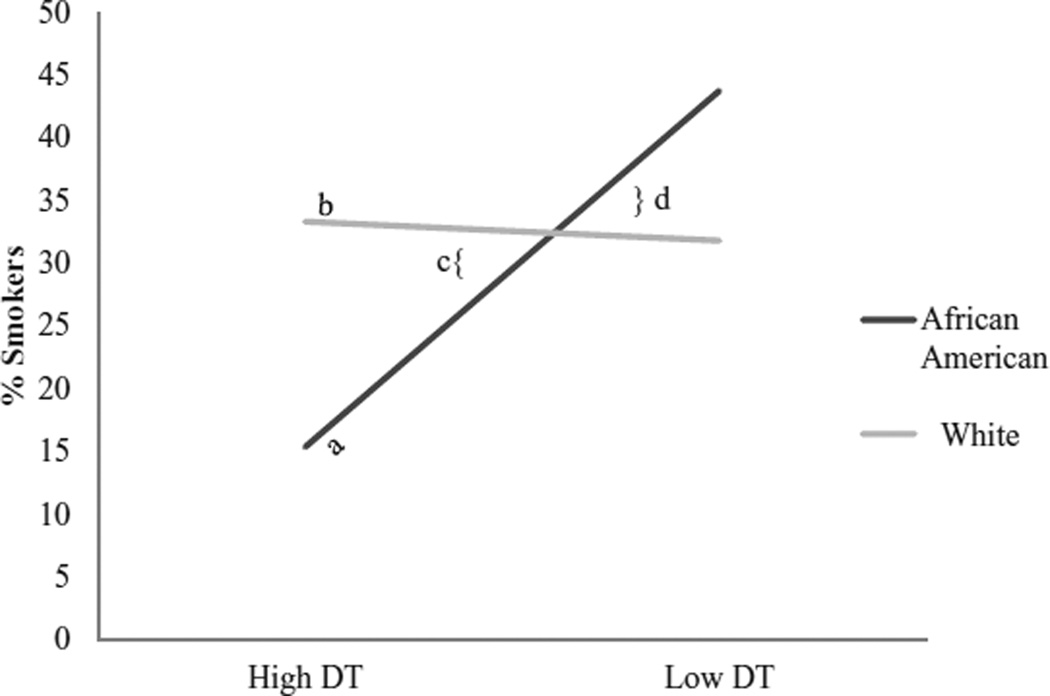Abstract
The present study examined the role of distress tolerance (DT) and race in relation to cigarette smoking. For this study, between 2008 and 2010, 153 women (62.1% White, 37.9% African American) from the Washington, DC metropolitan area completed a computerized behavioral DT task and self-reported smoking history. Results suggest that low DT (OR = .23, p = .03) and the interaction between DT and race (OR = 4.58, p = .05) were significantly related to greater odds of being a smoker, such that African American women, but not White women, with low DT were at increased risk for being a lifetime smoker.
Keywords: cigarette smoking, distress tolerance, race, disparities, high-risk groups
Cigarette smoking is the leading preventable cause of death and disability in the United States (Centers for Disease Control and Prevention (CDC), 2011). Smokers are seven times more likely than non-smokers to die of cancers of the lungs, nose, and throat (CDC, 2011; Pichandi et al., 2011). Furthermore, female smokers may be more susceptible than male smokers to the deleterious health effects of cigarette smoking, particularly lung cancer (Rivera, 2009). Smoking-attributable lung cancer is the leading cause of cancer-related death among women (United States Department of Health and Human Services [USDHHS], 2002) and lung cancer kills more women annually than breast, ovarian, and uterine cancers combined (Patel, 2005). In light of these health consequences, female smokers remain a critical group for continued research aimed at elucidation of the mechanisms underlying risk.
In addition to the gender disparity in smoking-related public health cost, African Americans experience a dis-proportionate amount of the smoking-related health burden, evidencing higher rates of smoking-attributable lung cancer than Whites (Haiman et al., 2006). Taking into consideration both gender and racial disparities, African American women may be a particularly vulnerable group for smoking-related health problems (e.g., lung cancer). Thus, it is important to identify potential risk factors associated with cigarette smoking in this group in order to inform prevention and intervention efforts aimed at reducing these health disparities. Distress tolerance (DT), which is currently conceptualized in the literature as an individual’s behavioral tendency to persist in goal-directed behavior despite physical and/or psychological distress (Brown, Lejuez, Kahler, Strong, & Zvolensky, 2005; Daughters et al., 2005; Zvolensky, Vujanovic, Bernstein, & Leyro, 2010), has been consistently related to cigarette smoking cessation (Abrantes et al., 2008; Brandon et al., 2003; Brown, Lejuez, Kahler, & Strong, 2002; Brown et al., 2005; Brown et al., 2009; Quinn, Brandon, & Copeland, 1996) and is a construct that may be useful for understanding smoking among African American women. Across studies including both men and women, current smokers evidence lower levels of behavioral DT than nonsmokers (Quinn et al., 1996), and individuals with higher levels of nicotine dependence persist for a shorter period of time on a behavioral DT task (Brandon et al., 2003). Further, following a period of abstinence, individuals lower in perceived DT exhibit greater total puff volumes (an index of smoking topography; Pomerleau & Pomerleau, 1987) for both nicotinized and denicotinized cigarettes compared to individuals high in DT (Perkins, Karelitz, Giedgowd, Conklin, & Sayette, 2010). Low behavioral DT is also consistently linked to poor smoking cessation outcomes, predicting pre-smoking cessation treatment attrition (MacPherson, Stipelman, Duplinsky, Brown, & Lejuez, 2008), earlier lapse to smoking after initiating a cessation attempt (Brown et al., 2002), and heightened risk for negative affect-induced relapse (Abrantes et al., 2008). Thus, across studies, DT is related to smoking status, smoking reinforcement, and smoking cessation. Despite these clear relationships between DT and multiple indices of cigarette smoking, the role of race has not yet been examined in the link between DT and smoking among women.
Although not yet examined, there is rationale suggesting that lower DT may be particularly relevant as a smoking-related vulnerability for African Americans. Specifically, poor health behaviors, such as cigarette smoking, can be conceptualized as one strategy to cope with distress that may function differently by race (Gerrard et al., 2012; Jackson & Knight, 2006; Sinha, 2001). Jackson and colleagues (2010) examined the relationship between unhealthy behaviors (e.g., cigarette/cigar smoking, alcohol use, frequency of eating balanced meals) and major depression, a disorder they highlight as one consequence of chronic stress coupled with limited distress coping strategies, among a sample of African American and White respondents to the Americans’ Changing Lives study (House et al., 1994). Jackson and colleagues (2010) found that among Whites, the relationship between stressors and meeting criteria for major depression was strongest among those endorsing a greater number of negative health behaviors. In contrast, among African Americans, the relationship between stressors and likelihood of meeting criteria for major depression was strongest among those not engaging in unhealthy behaviors. Similar results have been reported by Mezuk and colleagues (2010). Taken together, these results suggest that certain distress coping strategies may differ by race and, further, these differences in DT may convey additional risk for engaging in negative health behaviors such as cigarette smoking. Considering that African Americans who were less likely to meet criteria for major depression were more likely to engage in negative health behaviors, African Americans low in DT who, in turn, use negative health behaviors to cope with distress, may be at greatest risk for smoking-related consequences. Thus, the interaction of chronic stress and limited distress coping skills may contribute to observed racial disparities in smoking-related health problems. As such, African American women in particular may be at risk for engaging in unhealthy behaviors such as cigarette smoking in order to cope with stressors, and DT may be a useful factor for further investigating racial disparities in smoking-related health consequences.
The aim of the present study was to examine the relationship between DT and cigarette smoking, with a specific focus on the potential interaction between DT and race in predicting cigarette smoking status among a sample of adult women residing in the Washington, DC metropolitan area. In light of work suggesting that engagement in certain negative health behaviors may be a distress management tool for African Americans, but not for Whites (Jackson et al., 2010; Mezuk et al., 2010), we hypothesized that low levels of DT would be related to smoking status for African American women, but not for White women. In addition, in line with previous work in the smoking and substance use field, we focused specifically on a widely used behavioral index of DT (Lejuez, Kahler, & Brown, 2003) as a means of comparison to the extant literature.
METHODS
Participants
This study utilized data from the fourth wave of an ongoing longitudinal study of families with an adolescent child (Cummings et al., 2013; MacPherson, Magidson, Reynolds, Kahler, & Lejuez, 2010; Schmidt et al., 2010). The aim of the larger longitudinal study is to investigate predictors of adolescent risk-taking behavior. The majority of the mother sample (76.2%) was African American or White. As such, and with the aforementioned aims of the present study in mind, African American and White mothers were the focus of the current study. The fourth assessment wave was chosen because it was the first in which the adolescents’ mothers completed a DT assessment. In this study, mothers of the adolescent participants completed a battery of measures during their children’s assessment sessions. The original parent sample included 162 White and African American mothers (61.7% White, 38.3% African American). Of these 162 participants, DT and smoking history data were available for 153 participants (62.1% White, 37.9% African American). The mean age of the final 153 participants was 45.31 (SD = 6.0). Annual household income was collapsed into quartiles and 22.2% of the sample reported income between $0 and $48,000, 23.5% reported income between $48,001 and $85,000, 20.3% reported income between $85,001 and $120,000, and 34.0% reported income above $120,000. Regarding education, 1.3% of the sample completed some high school, 5.3% completed a high school degree or GED, 1.3% completed technical or trade school, 22.0% completed some college, 8.0% completed an associate’s degree, 27.3% completed a 4-year degree, and 33.3% completed an advanced degree. Participants were excluded due to missing smoking and/or DT data. Excluded participants did not significantly differ from those included in the present analyses on demographic factors (age, race, education, income, all p’s for χ2 analyses >.05).
Procedure
Permission to conduct research was obtained from the University of Maryland Institutional Review Board. After providing informed consent, participants were escorted into a private room at which time procedures were described and participants were informed that they would be completing a number of self-report questionnaires and computerized tasks. After description of procedures, participants filled out the self-report questionnaires and completed the computerized DT task [a computerized version of the Paced Auditory Serial Attention Task (PASAT-C; Lejuez et al., 2003)] on a laptop computer. The order of computerized tasks was counterbalanced across participants. Sessions lasted approximately 1 hour.
Measures
Demographic information
Participants completed a basic demographics form for personal information. The form included age, gender, race, and annual family income. Age and income were coded continuously while race was coded categorically with White as the reference group.
Distress tolerance
We used a modified, computerized version of the Paced Auditory Serial Attention Task (PASAT-C; Lejuez et al., 2003) as a behavioral measure of DT. We selected a behavioral measure of DT in order to evaluate DT in an ecologically valid manner and limit social desirability bias (McHugh et al., 2011). In the PASATC, numbers are sequentially presented on the screen and participants are instructed to add the currently presented number to the previously presented number and to click on the correct answer on the computer screen before the next number appears on the screen. The task consisted of three difficulty levels. The first difficulty level lasted 3 minutes and began with a 5-second latency between presented numbers. This levelwas titrated on the basis of skill such that latency decreased by .5 seconds with each correct response and increased by .5 seconds with each incorrect response. Level two lasted 3 minutes, with a constant latency set at 75% of the level one average latency for the first 2 minutes and at 50% of the level one average latency for the third minute. The final level was also set at 50% of the level one average latency and lasted up to 7 minutes. Participants were informed that once the final level began, they could terminate the task at any time by pressing a button on the provided computer keyboard; however, they were instructed that the amount of money they would earn at the end of the session depended upon task performance. Psychological DT was measured as latency in seconds to task termination. Participants completed the 20-item Positive and Negative Affect Schedule (PANAS; Watson, Clark, & Tellegen, 1988) prior to level one of the PASAT-C and following level two to determine if the task increased psychological distress. This scale included 10 positive (e.g., happy, excited) and 10 negative (e.g., upset, distressed) adjectives rated on a 1 (not at all) to 5 (extremely) Likert scale.
Cigarette smoking history
Participants were asked to self-report whether they smoked at least 100 cigarettes in their entire lives. The primary dependent variable, lifetime cigarette smoking, was coded categorically with nonsmoker defined as smoking less than 100 cigarettes lifetime and smoker defined as smoking 100 or more cigarettes lifetime, consistent with accepted definitions of established smoking (CDC, 2002).
Data Analysis Plan
The proportion of participants who terminated the PASAT-C before the high difficulty level time period expired was examined to determine whether to treat the DT variable categorically or continuously. Given the distribution, DT was used as a dichotomous variable; approximately half of the sample (49.7%, n = 76) quit the task before the full duration of the final level (7 minutes), and were labeled as “low DT;” those who persisted for the full duration of the final level of the task were labeled as “high DT,” consistent with previous research (e.g., Brown et al., 2002; Gorka, Ali, & Daughters, 2011; Lejuez et al., 2003).
Baseline demographic data (age, income, race), change in negative affect during the PASAT-C, and task termination were first examined for associations with lifetime smoking status. These variables were not significantly associated with lifetime smoking status and, thus, were not included as covariates in subsequent regression analyses. Next, we examined the bivariate relationship between the variables of interest (race, cigarette smoking, DT). Hierarchical logistic regression analyses were then conducted to examine the potential impact of race on the relationship between DT and smoking status (0 = nonsmoker, 1 = smoker). For these analyses, DT was dummy-coded with high DT as the reference group (i.e., coded 0) and low DT coded as 1. Race was coded with Whites as the reference group (i.e., coded as 0). The interaction between DT and race was included in the final regression step.
In order to further explore the potential interaction, follow-up analyses were conducted by completing two separate logistic regressions. In the first logistic regression, we examined the impact of DT on cigarette smoking separately in African Americans and Whites. In the second logistic regression, we examined the impact of race on cigarette smoking separately in High and Low DT individuals.
RESULTS
Descriptive Data
Distress Tolerance
Individuals persisted on the PASAT-C for an average of 270.1 seconds (SD = 175.7, Skewness = −.53). Paired t tests indicated a significant increase in self-reported negative affect from pre- to posttask (p < .001), suggesting that the task was psychologically stressful. A one-way ANOVA comparing change in negative affect from pre- to posttask in those who quit vs. those who did not quit revealed no significant differences between groups, F (1, 152) = .20, p = .66, suggesting that the task was equally stressful for both groups.
Cigarette Smoking
The prevalence of current smoking in our sample was relatively low, with 11.9% of the sample reporting cigarette smoking during the last 30 days (n = 18, 38.9% African American) and 7.3% reporting past month daily smoking (n = 11, 45.5% African American)1. Due to low rates of current smoking in our sample, we used a lifetime smoking variable to increase our statistical power. Sixty-eight percent (n = 104) of participants reported smoking less than 100 cigarettes during their lifetime (classified as “non-smokers”), while 32.0% (n = 49) reported smoking 100 or more cigarettes during their lifetime (classified as “smokers”).
Bivariate Correlations
We examined the bivariate correlations between our variables of interest (race, cigarette smoking, DT) to further understand the nature of our data. All bivariate correlations were nonsignificant (all p’s > .20).
Distress Tolerance and Cigarette Smoking
To determine the unique correlates of lifetime smoking status, we conducted a logistic regression with two smoking categories, (1) nonsmoker and (2) lifetime smoker. Race and DT were entered in the first step of the regression and the interaction between race and DT was entered in the final step of the regression (Table 1). The second step of the model indicated a significant improvement in fit, Δχ2 (df = 1) = 4.0, p = .05. In this final model, low DT (OR = .23, 95% CI = .07–.84, p = .03) significantly predicted smoking status. The interaction between DT and race (OR = 4.58, 95% CI = .99–21.33, p = .052) yielded a trend toward significance (Figure 1).
TABLE 1.
Binary logistic regression predicting lifetime cigarette smoking
| Predictor | B | SE(B) | Wald | OR | 95% CI | |
|---|---|---|---|---|---|---|
| Step 1 | ||||||
| Ethnicity | .12 | .36 | .10 | 1.12 | .55 | 2.28 |
| Distress Tolerance | −.45 | .35 | 1.66 | .63 | .32 | 1.27 |
| Step 2 | ||||||
| Ethnicity | −.51 | .48 | 1.13 | .60 | .23 | 1.54 |
| Distress Tolerance* | −1.45 | .65 | 5.00 | .23 | .07 | .84 |
| DT × Ethnicity+ | 1.52 | .78 | 3.77 | 4.58 | .99 | 21.33 |
p = .03.
p = .052.
FIGURE 1.
The interaction between DT and ethnicity for predicting lifetime smoking status. (a)Within African Americans, low DT is significantly related to smoking status (OR = .23, 95% CI = .07–.84, p = .03). (b) Within Whites, there is no significant relationship between DT and smoking status (OR = 1.07, 95% CI = .45–2.54, p = .88). (c) Among individuals high in DT, race does not significantly predict smoking status [F(1, 75) = 2.83, p = .10)]. (d) Among individuals low in DT, race does not significantly predict smoking status [F(1, 74) = 1.12, p = .29].
Although the significance for the interaction did not quite meet the p < .05 threshold, given the reasonably robust odds ratio and because this is a new line of research, we used logistic regression analyses to further probe the interaction between DT and race. First, analysis of the sample of African American mothers showed that high DT was associated with significantly decreased odds of being a lifetime smoker (OR = .23, 95% CI = .07–.84, p = .03); among White mothers, this association was not significant (OR = 1.07, 95% CI = .45–2.54, p = .88). Second, within the high DT group, race was not significantly related to smoking status, F(1, 75) = 2.83, p = .10. The same was true within the low DT group such that race was not significantly related to smoking status, F(1, 74) = 1.12, p = .29 (Figure 1). For proportion of lifetime smokers and nonsmokers in each DT × race group, see Table 2.
TABLE 2.
Proportion of lifetime smokers and nonsmokers in each DT × Race group
| Low DT (n = 76) | High DT (n = 77) | ||
|---|---|---|---|
| White (n = 95) | Lifetime smoker (n = 31) | 31.81% (n = 14) | 33.33% (n = 17) |
| Lifetime nonsmoker (n = 64) | 68.18% (n = 30) | 66.67% (n = 34) | |
| African American (n = 58) | Lifetime smoker (n = 18) | 43.75% (n = 14) | 15.38% (n = 4) |
| Lifetime nonsmoker (n = 40) | 56.25% (n = 18) | 84.62% (n = 22) |
Percentages represent the proportion of participants within each racial/DT/smoking group. For example, 31.81% of low DT Whites in the sample were lifetime smokers.
DISCUSSION
Research on mechanisms of cigarette smoking has supported the role of DT in relation to smoking status (e.g., Brandon et al., 2003; Brown et al., 2002; Quinn et al., 1996) and smoking cessation outcomes (e.g., Abrantes et al., 2008; Brown et al., 2009; MacPherson et al., 2008). Cigarette smoking can be conceptualized as a distress management tool, and there is some evidence that race plays a role in the relationship between emotional distress and engagement in negative health behaviors (Jackson & Knight, 2006). Less is known, however, about the specific relationship between race, DT, and smoking. To this end, the present study aimed to fill this gap in the literature by examining the role of race in the link between DT and cigarette smoking history in a sample of adult women. A better understanding of individual differences in risk factors for cigarette smoking is of heightened importance for groups who may experience a disproportionate smoking-related health burden, such as African American women.
Results from the present study suggest a differential relationship between cigarette smoking and DT when comparing African American and White women, such that low DT among African American women, but not White women, is associated with significantly greater odds of lifetime cigarette smoking. These findings add further support to recent work suggesting that negative health behaviors may serve a distress management function for some individuals, and that engagement in certain negative health behaviors may by related, in part, to race (Jackson et al., 2010; Mezuk et al., 2010). While previous literature has suggested that low DT is a general risk factor for cigarette smoking (Quinn et al., 1996), these findings suggest a unique interaction between race, smoking, and DT. Although we were unable to examine mechanisms of this relationship in the present study, previous research suggests that racial differences in distress management may be due, in part, to environmental differences between individuals of different racial backgrounds such as inequalities in employment, educational opportunities, income, access to health care, and access to formal education (Mezuk et al., 2010; Richardson & Norris, 2010; Williams, Mohammed, Leavell, & Collins, 2010). Elucidating this underlying relationship between race, DT, and cigarette smoking is important for the development or refinement of targeted smoking cessation treatments, as well as for prevention efforts.
Limitations
There were several limitations to the present study. First, smoking status was defined according to lifetime smoking history, as rates of current cigarette smoking in our sample were relatively low. While our classification of lifetime smoking status is consistent with accepted definitions (CDC, 2002), a concern remains that we did not examine current smoking, and that we did not capture severity of nicotine dependence in our assessment and, as such, generalizability of the findings may be limited. However, despite low rates of current cigarette smoking, the expected relationship between low DT and cigarette smoking was supported. A second limitation is that we used a lifetime measure of cigarette smoking and a current behavioral indicator of DT. Previous literature suggests that DT is a relatively stable and trait-like “higher-order construct” (Simons & Gaher, 2005). Considering the stability of DT, our results can be interpreted such that low DT may represent a general risk factor for cigarette smoking among African American women across the lifespan; however, this should be empirically examined. Along these lines, we cannot eliminate the possibility that cigarette smoking may contribute to lower DT. A third limitation of the present study was that we were unable to probe differences in environmental stressors that have been previously suggested to be at the core of racial differences in mental and physical health (Jackson et al., 2010). Future studies should include measures of health disparities and other educational and economic factors that have been implicated in understanding patterns of negative health behaviors between racial groups (Margerison-Zilko & Cubbin, 2013). Finally, the confidence interval around our statistical interaction term was quite wide, and therefore this result should be interpreted cautiously. This wide confidence interval is likely due to low expected cell counts for prediction of lifetime smoker group membership (see Table 2). Follow-up study with a larger sample will allow for more confident conclusions to be drawn regarding the strength of this association.
CONCLUSIONS
With these limitations in mind, this study implicates the interaction between race and DT in its association with cigarette smoking and, to our knowledge, is the first study to examine this unique relationship. Results of the study have several implications for understanding the role of DT in cigarette smoking. Findings provide support for existing theories of racial/ethnic differences in negative health behaviors as a function of distress management strategies (e.g., Braveman et al., 2010; Jackson et al., 2010; Mezuk et al., 2010), and this differential association between emotional distress and negative health behaviors is an important public health concern. As the underlying mechanisms for smoking behaviors are better understood, assessments and interventions can be individually tailored to maximize prevention efforts and treatment success. For example, targeted interventions that emphasize healthy distress management techniques could be added to existing smoking prevention or cessation interventions, and one such treatment has already shown promise (Brown et al., 2008). Identification of those individuals most at risk for low DT could inform allocation of education and smoking prevention efforts, such that strategies that seek to influence cultural or social norms for stress management behaviors may be developed for these at-risk populations.
Acknowledgments
This research was supported by a grant from the National Institute of Drug Abuse (R01 DA018647).
GLOSSARY
- Distress Tolerance (DT)
An individual’s behavioral tendency to persist in a goal-directed behavior despite physical and/or psychological distress.
Biographies

Jennifer Dahne received her M.S. from the University of Maryland, College Park in 2013. She is currently a doctoral candidate in Clinical Psychology at the University of Maryland, College Park. Her research focuses on factors that contribute to the initiation and maintenance of cigarette smoking.

Kelcey J. Stratton received her Ph.D. in Clinical Psychology in 2012 from The New School for Social Research, and she is currently a postdoctoral fellow at Hunter Holmes McGuire VA Medical Center in Richmond, Virginia. Her research interests include risk and protective factors for posttraumatic stress disorder and chronic pain, particularly among U.S. military veterans.

Ruth Brown received her Ph.D. in Clinical Psychology from Virginia Commonwealth University in December of 2011. Her primary research interests are the development and dissemination of evidence-based assessments and treatments for anxiety, depression, and trauma in youth. In particular, she is interested in the use of multimodal assessment strategies to improve diagnosis and evaluate treatment processes and outcomes. She is also interested in the adaptation and evaluation of evidence-based practices for youth with intellectual disabilities.

Ananda B. Amstadter is an Assistant Professor of Psychiatry at the Virginia Institute for Psychiatric and Behavioral Genetics at Virginia Commonwealth University. Her program of research centers on the identification of risk and resilience factors for traumatic stress related psychopathology.

Carl W. Lejuez is a professor and the Director of Clinical Training in the Clinical Psychology Program at the University of Maryland. He is the Founder and Director of the Center for Addictions, Personality, and Emotion Research (CAPER), Co-Director of a NIDA T32 Institutional Training Program at the intersection of basic science and addictions treatment development, and Founding Editor of the American Psychological Association Journal Personality Disorders: Theory, Research, and Treatment. His research has been continually funded by the National Institutes of Health (NIH) since 2002 and he has published extensively in the areas of addictions, personality pathology, and mood disorders.

Laura MacPherson is an Associate Professor of Psychology at the University of Maryland, College Park. Her research focuses on a developmentally informed examination of the progression and cessation of addictive behaviors among adolescents and young adults to improve youth-tailored interventions, as well as developing behavioral treatments for adult smokers with psychiatric comorbidities.
Footnotes
Of the full sample, current (past 30 days) cigarette smoking information was available for 151 participants. 7.3% (n = 11, 45.5% African American) of the sample reported smoking daily during the last month. Of participants reporting smoking during the last 30 days, cigarettes per smoking day (CPSD) data were available for 17 of the 18 participants. Of these individuals, average CPSD was 7.8 ± 5.1 [White CPSD M(SD) = 8.7 ± 5.8; African American CPSD M(SD) = 6.6 ± 3.9].
Declaration of Interest
The authors report no conflicts of interest. The authors alone are responsible for the content and writing of this article.
REFERENCES
- Abrantes AM, Strong DR, Lejuez CW, Kahler CW, Carpenter LL, Price LH, et al. The role of negative affect in risk for early lapse among low distress tolerance smokers. Addictive Behaviors. 2008;33(11):1394–1401. doi: 10.1016/j.addbeh.2008.06.018. [DOI] [PMC free article] [PubMed] [Google Scholar]
- Brandon TH, Herzog TA, Juliano LM, Irvin JE, Lazev AB, Simmons VN. Pretreatment task persistence predicts smoking cessation outcome. Journal of Abnormal Psychology. 2003;112(3):448–456. doi: 10.1037/0021-843x.112.3.448. [DOI] [PubMed] [Google Scholar]
- Braveman PA, Cubbin C, Egerter S, Williams DR, Pamuk E. Socioeconomic disparities in health in the United States: What the patterns tell us. American Journal of Public Health. 2010;100(S1):186–196. doi: 10.2105/AJPH.2009.166082. [DOI] [PMC free article] [PubMed] [Google Scholar]
- Brown RA, Lejuez C, Kahler CW, Strong DR. Distress tolerance and duration of past smoking cessation attempts. Journal of Abnormal Psychology. 2002;111(1):180–185. [PubMed] [Google Scholar]
- Brown RA, Lejuez C, Kahler CW, Strong DR, Zvolensky MJ. Distress tolerance and early smoking lapse. Clinical Psychology Review. 2005;25(6):713–733. doi: 10.1016/j.cpr.2005.05.003. [DOI] [PMC free article] [PubMed] [Google Scholar]
- Brown RA, Lejuez C, Strong DR, Kahler CW, Zvolensky MJ, Carpenter LL, et al. A prospective examination of distress tolerance and early smoking lapse in adult self-quitters. Nicotine & Tobacco Research. 2009;11(5):493–502. doi: 10.1093/ntr/ntp041. [DOI] [PMC free article] [PubMed] [Google Scholar]
- Brown RA, Palm KM, Strong DR, Lejuez CW, Kahler CW, Zvolensky MJ, et al. Distress tolerance treatment for early-lapse smokers rationale, program description, and preliminary findings. Behavior Modification. 2008;32(3):302–332. doi: 10.1177/0145445507309024. [DOI] [PMC free article] [PubMed] [Google Scholar]
- Center for Disease Control. Cigarette smoking among adults—United States, 2000. Morbidity and Mortality Weekly Report. 2002;51(29):642–645. [PubMed] [Google Scholar]
- Center for Disease Control. Vital signs: Current cigarette smoking among adults aged ≥18 years—United States, 2005–2010. Morbidity and Mortality Weekly Report. 2011;60(35):1207–1212. [PubMed] [Google Scholar]
- Cummings JR, Bornovalova MA, Ojanen T, Hunt E, MacPherson L, Lejuez C. Time doesn’t change everything: The longitudinal course of distress tolerance and its relationship with externalizing and internalizing symptoms during early adolescence. Journal of Abnormal Child Psychology. 2013;41(5):735–748. doi: 10.1007/s10802-012-9704-x. [DOI] [PMC free article] [PubMed] [Google Scholar]
- Daughters SB, Lejuez C, Bornovalova MA, Kahler CW, Strong DR, Brown RA. Distress tolerance as a predictor of early treatment dropout in a residential substance abuse treatment facility. Journal of Abnormal Psychology. 2005;114(4):729–734. doi: 10.1037/0021-843X.114.4.729. [DOI] [PubMed] [Google Scholar]
- Gerrard M, Stock ML, Roberts ME, Gibbons FX, O’Hara RE, Weng C-Y, et al. Coping with racial discrimination: The role of substance use. Psychology of Addictive Behaviors. 2012;26(3):550–560. doi: 10.1037/a0027711. [DOI] [PMC free article] [PubMed] [Google Scholar]
- Gorka SM, Ali B, Daughters SB. The role of distress tolerance in the relationship between depressive symptoms and problematic alcohol use. Psychology of Addictive Behaviors. 2011;26(3):621–626. doi: 10.1037/a0026386. [DOI] [PMC free article] [PubMed] [Google Scholar]
- Haiman CA, Stram DO, Wilkens LR, Pike MC, Kolonel LN, Henderson BE, et al. Ethnic and racial differences in the smoking-related risk of lung cancer. New England Journal of Medicine. 2006;354(4):333–342. doi: 10.1056/NEJMoa033250. [DOI] [PubMed] [Google Scholar]
- House JS, Lepkowski JM, Kinney AM, Mero RP, Kessler RC, Herzog AR. The social stratification of aging and health. Journal of Health and Social Behavior. 1994;35(3):213–234. [PubMed] [Google Scholar]
- Jackson JS, Knight KM. Race and self-regulatory health behaviors: The role of the stress response and the HPA axis in physical and mental health disparities. In: Schaie KW, Carstensen LL, editors. Social structures, aging, and self-regulation in the elderly. New York: Springer Publishing Co.; 2006. pp. 189–207. [Google Scholar]
- Jackson JS, Knight KM, Rafferty JA. Race and unhealthy behaviors: Chronic stress, the HPA axis, and physical and mental health disparities over the life course. American Journal of Public Health. 2010;100(5):933–939. doi: 10.2105/AJPH.2008.143446. [DOI] [PMC free article] [PubMed] [Google Scholar]
- Lejuez C, Kahler CW, Brown RA. A modified computer version of the Paced Auditory Serial Addition Task (PASAT) as a laboratory-based stressor. The Behavior Therapist. 2003;26(4):290–293. [Google Scholar]
- MacPherson L, Magidson JF, Reynolds EK, Kahler CW, Lejuez C. Changes in sensation seeking and risk taking propensity predict increases in alcohol use among early adolescents. Alcoholism: Clinical and Experimental Research. 2010;34(8):1400–1408. doi: 10.1111/j.1530-0277.2010.01223.x. [DOI] [PMC free article] [PubMed] [Google Scholar]
- MacPherson L, Stipelman BA, Duplinsky M, Brown RA, Lejuez C. Distress tolerance and pre-smoking treatment attrition: Examination of moderating relationships. Addictive Behaviors. 2008;33(11):1385–1393. doi: 10.1016/j.addbeh.2008.07.001. [DOI] [PMC free article] [PubMed] [Google Scholar]
- Margerison-Zilko C, Cubbin C. Socioeconomic disparities in tobacco-related health outcomes across race/ethnic groups in the United States: National Health Interview Survey 2010. Nicotine & Tobacco Research. 2013;15(6):1161–1165. doi: 10.1093/ntr/nts256. [DOI] [PubMed] [Google Scholar]
- McHugh RK, Daughters SB, Lejuez CW, Murray HW, Hearon BA, Gorka SM, et al. Shared variance among self-report and behavioral measures of distress intolerance. Cognitive Therapy and Research. 2011;35(3):266–275. doi: 10.1007/s10608-010-9295-1. [DOI] [PMC free article] [PubMed] [Google Scholar]
- Mezuk B, Rafferty JA, Kershaw KN, Hudson D, Abdou CM, Lee H, et al. Reconsidering the role of social disadvantage in physical and mental health: Stressful life events, health behaviors, race, and depression. American Journal of Epidemiology. 2010;172(11):1238–1249. doi: 10.1093/aje/kwq283. [DOI] [PMC free article] [PubMed] [Google Scholar]
- Patel JD. Lung cancer in women. Journal of Clinical Oncology. 2005;23(14):3212–3218. doi: 10.1200/JCO.2005.11.486. [DOI] [PubMed] [Google Scholar]
- Perkins KA, Karelitz JL, Giedgowd GE, Conklin CA, Sayette MA. Differences in negative mood-induced smoking reinforcement due to distress tolerance, anxiety sensitivity, and depression history. Psychopharmacology. 2010;210(1):25–34. doi: 10.1007/s00213-010-1811-1. [DOI] [PMC free article] [PubMed] [Google Scholar]
- Pichandi S, Pasupathi P, Rao YY, Farook J, Ponnusha BS, Ambika A, et al. The effect of smoking on cancer-a review. International Journal of Biological and Medical Research. 2011;2(2):593–602. [Google Scholar]
- Pomerleau CS, Pomerleau OF. The effects of a psychological stressor on cigarette smoking and subsequent behavioral and physiological responses. Psychophysiology. 1987;24(3):278–285. doi: 10.1111/j.1469-8986.1987.tb00295.x. [DOI] [PubMed] [Google Scholar]
- Quinn EP, Brandon TH, Copeland AL. Is task persistence related to smoking and substance abuse? The application of learned industriousness theory to addictive behaviors. Experimental and Clinical Psychopharmacology. 1996;4(2):186–190. [Google Scholar]
- Richardson LD, Norris M. Access to health and health care: How race and ethnicity matter. Mount Sinai Journal of Medicine: A Journal of Translational and Personalized Medicine. 2010;77(2):166–177. doi: 10.1002/msj.20174. [DOI] [PubMed] [Google Scholar]
- Rivera MP. Lung cancer in women: The differences in epidemiology, biology and treatment outcomes. Expert Review of Respiratory Medicine. 2009;3(6):627–634. doi: 10.1586/ers.09.54. [DOI] [PubMed] [Google Scholar]
- Schmidt NB, Keough ME, Mitchell MA, Reynolds EK, MacPherson L, Zvolensky MJ, et al. Anxiety sensitivity: prospective prediction of anxiety among early adolescents. Journal of Anxiety Disorders. 2010;24(5):503–508. doi: 10.1016/j.janxdis.2010.03.007. [DOI] [PMC free article] [PubMed] [Google Scholar]
- Simons JS, Gaher RM. The distress tolerance scale: Development and validation of a self-report measure. Motivation and Emotion. 2005;29(2):83–102. [Google Scholar]
- Sinha R. How does stress increase risk of drug abuse and relapse? Psychopharmacology. 2001;158(4):343–359. doi: 10.1007/s002130100917. [DOI] [PubMed] [Google Scholar]
- USDHHS. Women and smoking: A report of the Surgeon General. Atlanta: Centers for Disease Control and Prevention; 2002. Retrieved from: http://www.ncbi.nlm.nih.gov/books/NBK44303/ [PubMed] [Google Scholar]
- Watson D, Clark LA, Tellegen A. Development and validation of brief measures of positive and negative affect: The PANAS scales. Journal of Personality and Social Psychology. 1988;54(6):1063–1070. doi: 10.1037//0022-3514.54.6.1063. [DOI] [PubMed] [Google Scholar]
- Williams DR, Mohammed SA, Leavell J, Collins C. Race, socioeconomic status, and health: complexities, ongoing challenges, and research opportunities. Annals of the New York Academy of Sciences. 2010;1186(1):69–101. doi: 10.1111/j.1749-6632.2009.05339.x. [DOI] [PMC free article] [PubMed] [Google Scholar]
- Zvolensky MJ, Vujanovic AA, Bernstein A, Leyro T. Distress tolerance theory, measurement, and relations to psychopathology. Current Directions in Psychological Science. 2010;19(6):406–410. doi: 10.1177/0963721410388642. [DOI] [PMC free article] [PubMed] [Google Scholar]



